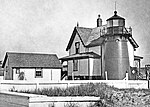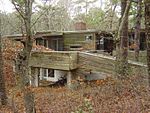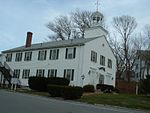Paine Hollow Road South Historic District
Barnstable County, Massachusetts Registered Historic Place stubsHistoric districts on the National Register of Historic Places in MassachusettsNRHP infobox with nocatNational Register of Historic Places in Barnstable County, MassachusettsUse mdy dates from August 2023 ... and 1 more
Wellfleet, Massachusetts

The Paine Hollow Road South Historic District is a residential historic district roughly along Paine Hollow Road, and Raywid Way in Wellfleet, Massachusetts. It consists of a cluster of seven 19th-century residences centered just north of Paine Hollow Road's junction with Pleasant Point Road and Baker Road, including one house on Baker Road and one on Rayvid Way. All seven houses were built by members of the locally prominent Paine family in the mid-19th century, and are predominantly Greek Revival in their styling.The district was listed on the National Register of Historic Places in 1999.
Excerpt from the Wikipedia article Paine Hollow Road South Historic District (License: CC BY-SA 3.0, Authors, Images).Paine Hollow Road South Historic District
Baker Road,
Geographical coordinates (GPS) Address Nearby Places Show on map
Geographical coordinates (GPS)
| Latitude | Longitude |
|---|---|
| N 41.913888888889 ° | E -70.0075 ° |
Address
Baker Road 18
02667
Massachusetts, United States
Open on Google Maps











